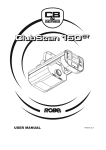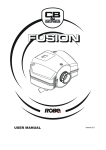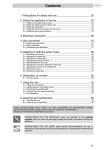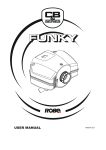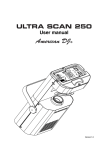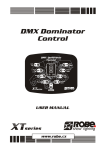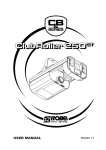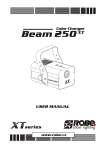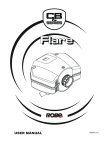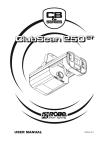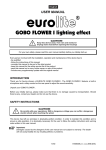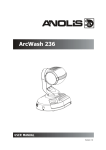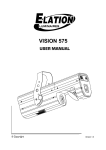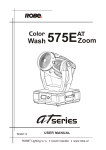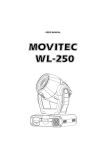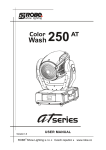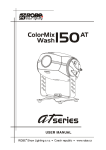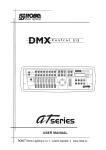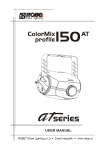Download "user manual"
Transcript
DJ ROLLER 150XT
Table of contents
1. Safety instructions ......................................................................................................... 3
2. Operating determinations ............................................................................................. 4
3. Description of the device .............................................................................................. 5
4. Installation ...................................................................................................................... 6
4.1Fitting/Exchanging the lamp ....................................................................................... 6
4.2 Rigging the fixture ..................................................................................................... 7
4.3 Connection to the mains ............................................................................................ 8
4.4 DMX-512 connection/connection between fixtures ................................................... 8
5. DMX PROTOCOL ............................................................................................................ 9
6. Addressing ................................................................................................................... 10
7. Control Board .............................................................................................................. 10
7.1. Main functions ........................................................................................................ 10
7.2. Special functions - calibration ................................................................................. 11
8.Technical specifications .............................................................................................. 11
9. Maintenance and cleaning .......................................................................................... 13
10. Appendix- Changing the power supply settings .................................................... 14
2
CAUTION!
Keep this device away from rain and moisture!
Unplug mains lead before opening the housing!
FOR YOUR OWN SAFETY, PLEASE READ THIS USER MANUAL CAREFULLY
BEFORE YOU INITIAL START - UP!
1. Safety instructions
Every person involved with installation and maintenance of this device have to:
- be qualilfied
- follow the instructions of this manual
CAUTION!
Be careful with your operations. With a high voltage you can suffer
a dangerous electric shock when touching the wires!
This device has left our premises in absolutely perfect condition. In order to maintain this condition and to ensure
a safe operation, it is absolutely necessary for the user to follow the safety instructions and warning notes written
in this manual.
Important:
The manufacturer will not accept liability for any resulting damages caused by the non-observance of this manual
or any unauthorized modification to the device.
Please consider that damages caused by manual modifications to the device are not subject to warranty.
Never let the power-cord come into contact with other cables! Handle the power-cord and all connections with the
mains with particular caution!
Always plug in the power plug least. The power-plug has to be accessable after installing the device.
Make sure that the power-cord is never crimped or damaged by sharp edges. Check the device and the powercord from time to time.
Always disconnect from the mains, when the device is not in use or before cleaning it. Only handle the power-cord
by the plug. Never pull out the plug by tugging the power-cord.
This device falls under protection class I. Therefore it is essential to connect the yellow/green conductor to earth.
The electric connection, repairs and servicing must be carried out by a qualified employee.
Do not connect this device to a dimmer pack.
Do not switch the fixture on and off in short intervals as this would reduce the lamp’s life.
During the initial start-up some smoke or smell may arise. This is a normal process and does not necessarily
mean that the device is defective.
Do not touch the device’s housing bare hands during its operation (housing becomes hot)!
For replacement use lamps and fuses of same type and rating only.
CAUTION ! EYEDAMAGES !
Avoid looking directly into the light source
(meant especially for epileptics)
3
2. Operating determinations
This device was designed for indoor use only.
If the device has been exposed to drastic temperature fluctuation (e.g. after transportation), do not switch it on
immediately. The arising condensation water might damage your device. Leave the device switched off until it has
reached room temperature.
When taking the device into operation, please make sure that the housing is closed firmly with all the necessary
screws tightened up.
Never run the device without lamp!
Do not shake the device. Avoid brute force when installing or operating the device.
When choosing the installation-spot, please make sure that the device is not exposed to extreme heat, moisture
or dust. There should not be any cables lying around. You endanger your own and the safety of others!
The symbol
determines the minimum distance from lighted objects. The minimum distance between lightoutput and the illuminated surface must be more than 0.8 meters.
Make sure that the area below the installation place is blocked when rigging, derigging or servicing the fixture.
Always fix the fixture with an appropriate safety-rope. Fix the safety-rope at the correct holes only.
Only operate the fixture after having checked that the housing is firmly closed and all screws are tightly fastened.
The lamp must never be ignited if the objective-lens or any housing-cover is open, as discharge lamps may
explose and emit a high ultraviolet radiation, which may cause burns.
The maximum ambient temperature ta = 45° C must never be exceeded. Otherwise, the lamp is switched off and
the fixture is out of operation for 5 minutes.
CAUTION!
The lens has to be replaced when it is obviously damaged,
so that its function is impaired, e. g. due to cracks or deep scratches!
Operate the device only after having familiarized with its functions. Do not permit operation by persons not
qualified for operating the device. Most damages are the result of unprofessional operation!
CAUTION!
The lamp has to be replaced when it is damaged
or deformed due to the heat!
Wait at least 15 minutes before remowing the lamp.
Please use the original packaging if the device is to be transported.
Please consider that unauthorized modifications on the device are forbidden due to safety reasons!
If this device will be operated in any way different to the one described in this manual, the product may suffer
damages and the guarantee becomes void. Furthermore, any other operation may lead to dangers like shortcircuit, burns, electric shock, burns due to ultraviolet radiation, lamp explosion, crash etc.
4
3. Description of the device
1 - Fastening screws
2 - Bracket
3 - Fixation screw for bracket
4 - Objective
5 - Drum
Front panel:
1 - Fuseholder
2 - Powercord
3 - DMX input
4 - DMX output
Control board:
1 - Menu button
2 - Up,Down buttons
3 - Display
5
4. Installation
4.1Fitting/Exchanging the lamp
DANGER !
Install the lamps with the device switched off only.
Unplug from mains before !
Screw "A"
Screw "B"
To insert the lamp open the small cover at the rear panel (see the drawing) by loosening the 2 Phillips screws "A"
and "B" on the cover.
Gently pull out the lamp assembly.
If changing the lamp, remove the old lamp from the socket. Insert the lamp to the socket.
Do not install a lamp with a higher wattage! A lamp like this generates temperatures the device is not designed for.
Damages caused by non-observance are not subject to warranty. Please follow the lamp manufacturer‘s notes!
Do not touch the glass-bulb bare hands during the installation! Make sure that the lamp is installed tightly into the
lampholder system.
Reinsert the lamp assembly and tighten the 2 screws again.
Do not operate this fixture with opened housing-cover!
Screw „X”
Screw „Z”
Screw „Y”
6
Lamp adjustment
The lampholder is aligned at the factory. Due to differences between lamps, fine adjustment may improve light
performance.
Strike the lamp and focus the light on a flat surface (wall). Center the hot-spot (the brightest part of the beam)
using the 3 adjustment screws "X, Y, Z". Turn one screw at a time to drag the hot-spot diagonally across the
projected image. If you cannot detect a hot-spot, adjust the lamp until the light is even.
To reduce a hot-spot, pull the lamp in by turning all three screws "X,Y, Z" clockwise ¼-turn at a time until the light
is evenly distributed.
If the light is brighter around the edge than it is in the center, or if light output is low, the lamp is too far back in the
reflector. „Push” the lamp out by turning the screws "X,Y,Z" counterclockwise ¼-turn at a time the light is bright
and evenly distributed.
4.2 Rigging the fixture
The installation of the projector has to be built and constructed in a way that it can hold 10 times the weight for 1
hour without any harming deformation.
The installation must always be secured with a secondary safety attachment, e.g. an appropriate catch net. This
secondary safety attachment must be constructed in a way that no part of the installation can fall down if the
main attachment fails.
When rigging, derigging or servicing the fixture staying in the area below the installation place, on bridges, under
high working places and other endangered areas is forbidden.
The operator has to make sure that safety-relating and machine-technical installations are approved by an expert
before taking into operation for the first time and after changes before taking into operation another time.
The operator has to make sure that safety-relating and machine-technical installations are approved by an expert
after every four year in the course of an acceptance test.
The operator has to make sure that safety-relating and machine-technical installations are approved by a skilled
person once a year.
The projector should be installed outside areas where persons may walk by or be seated.
Important! Overhead rigging requires extensive experience, including (but not limited to) calculating working load
limits, installation material being used, and periodic safety inspection of all installation material and the projector.
If you lack these qualifications, do not attempt the installation yourself, but instead use a professional structural
rigger. Improper installation can result in bodily injury and.or damage to property.
The projector has to be installed out of the reach of people.
If the projector shall be lowered from the ceiling or high joists, professional trussing systems have to be used.
The projector must never be fixed swinging freely in the room.
Caution: Projectors may cause severe injuries when crashing down! If you have doubts concerning the safety of
a possible installation, do not install the projector!
Before rigging make sure that the installation area can hold a minimum point load of 10 times the projector’s
weight.
Danger of fire !
When installing the device, make sure there is no highly-inflammable
material (decoration articles, etc.) within a distance of min. 0,5 m.
Mount the projector with the mounting-bracket to your trussing system using an appropriate clamp. The hole in the
mounting bracket has a diameter of 10 mm.
For overhead use, always install a safety-rope that can hold at least 10 times the weight of the fixture. You must
only use safety-ropes with screw-on carabines. Pull the safety-rope through the hole in the mounting-bracket and
over the trussing system etc. Insert the end in the carabine and tighten the fixation screw.
Adjust the desired inclination-angle via the mounting-bracket and fix the bracket-screws tightly.
Connect the fixture to the mains with the power-plug.
7
4.3 Connection to the mains
The earth has to be connected!
Connect the fixture to the mains with the enclosed power-plug.
The occupation of the connection-cables is as follows:
Cable (EU)
Cable (US)
Pin
International
L
Brown
Black
Live
Light blue
White
Neutral
Yellow/Green
Green
Earth
N
DANGER TO LIFE!
Before taking into operation for the first time,
the installation has to be approved by an expert!
4.4 DMX-512 connection/connection between fixtures
The wires must not come into contact with each other, otherwise
the fixtures will not work at all, or will not work properly.
Only use a stereo shielded cable and 3-pin XLR-plugs and connectors in order to connect the controller with the
fixture or one fixture with another.
Occupation of the XLR-connection:
DMX - output
DMX-input
XLR mounting-socket:
XLR mounting-plug:
1 - Ground
2 - Signal (-)
3 - Signal (+)
1 - Ground
2 - Signal (-)
3 - Signal (+)
If you are using standard controllers, you can connect the DMX-output of the controller directly with the DMXinput of the first fixture in the DMX-chain. If you wish to connect DMX-controllers with other XLR-outputs, you
need to use adapter-cables.
Building a serial DMX-chain:
Connect the DMX-output of the first fixture in the DMX-chain with the DMX-input of the next fixture. Always
connect one output with the input of the next fixture until all fixtures are connected.
Caution: At the last fixture, the DMX-cable has to be terminated with a terminator. Solder a 120 Ohm resistor
between Signal (–) and Signal (+) into a 3-pin XLR-plug and plug it in the DMX-output of the last fixture.
8
5. DMX PROTOCOL
Channel
Value
Function
0-255
Declination of the drum axis
Control of the declination of the drum rotation axis
proportional
0
1-125
126-129
130-255
Rotation of the drum round its rotation axis
No rotation
Forwards rotation from fast to slow
No rotation
Backwards rotation from slow to fast
step
proportional
step
proportional
0-7
8 - 15
16 - 23
24 - 31
32 - 39
40 - 47
48 - 55
56 - 63
64 - 71
72 - 79
80 - 87
88 - 95
96 - 103
104 - 111
112 - 119
120 - 127
128 - 189
190 - 193
194 - 255
Colours
Open/white
Turquoise
Red
Cyan
Light green
Magenta
Light blue
Yellow
Green
Pink
Blue
Orange
UV
Red/blue
Yellow/Green
Blue/purple
Forwards rainbow effect from fast to slow
No rotation
Backwards rainbow effect from slow to fast
step
step
step
step
step
step
step
step
step
step
step
step
step
step
step
step
proportional
step
proportional
0-5
6 - 63
64-127
128-132
133- 135
136-143
144-151
152-159
160- 167
168- 175
176- 183
184- 191
192- 199
200- 207
208- 215
216- 223
224- 231
232-239
240-247
248-255
Shutter,Strobe,Gobos
Closed
Open
Strobe effect from slow to fast (max 8FPS)
Closed
Reset of the fixture
Open
Closed
Gobo 1
Gobo 2
Gobo 3
Gobo 4
Gobo 5
Gobo 6
Gobo 7
Gobo 8
Gobo 9
Gobo 10
Gobo 11
Gobo 12
Gobo 13
step
step
proportional
step
step
step
step
step
step
step
step
step
step
step
step
step
step
step
step
step
1
2
3
4
9
Type of control
6. Addressing
The control board on the top side of the DJ ROLLER 150 XT allows you to assign the DMX fixture address, which
is defined as the first channel from which the DJ ROLLER 150XT will respond to the controller.
If you set, for example, the address to channel 5, the DJ ROLLER 150XT will use the channel 5 to 8 for control.
Please, be sure that you don’t have any overlapping channels in order to control each DJ ROLLER 150XT
correctly and independently from any other fixture on the DMX data link.
If two, three or more DJ ROLLER 150XT are addressed similarly, they will work similarly.
For address setting follow this procedure:
1. Switch On the DJ ROLLER 150XT and wait until the fixture reset has finished ("rES" is flashing at the display).
2. Browse through the menu by pressing the [ Up ] and [ Down ] keys until the display shows current addres
"001".
Confirm by pressing [ Menu ] key and "001" will start to flash frequently.
3. Use the [ Up ] and [Down ] keys to select the desired address.
4. Confirm by pressing [ Menu] .
Controlling:
After having addressed all DJ ROLLER 150XT, you may now start operating these via your lighting controller.
Note:
After switching on, the DJ ROLLER 150XT will automatically detect whether DMX 512 data are received. If there
are not received these data’s at the DMX input, the display will start to flash slowly "001" with actually set
address.
This situation can be occurred if:
there is not connected the 3 PIN XLR plug (cable with DMX signal from controller) in the input of the DJ ROLLER
150XT the controller is switch Off or is failed
the cable or connector is failed or the signal wires are swap in the input connector.
Note:
It’s necessary to insert the XLR termination plug (with 120 Ohm) in the last lighting in the link in order to ensure
proper transmission on the DMX data link.
7. Control Board
The control board situated on the top side of the DJ ROLLER 150XT offers several features. You can simply set
the lighting address, run test show, make a reset and also use special functions.
Browse through the menu by the pressing [ Up ] and [Down ] keys - the display shows step by step these
messages: "001, rdr,tSt, rES". Press [ Menu ] if you wish to select one of them. The functions provided are
described in the following sections and the function hierarchy is shown below.
7.1. Main functions
DMX 512 Address settings
The "001" flashes. Use the [ Up ] and [ Up ] keys to select required address (001 - 509) and press [ Menu ] to
confirm and return to the main menu.
Drum declination reverse
This function allows you to invert the the declination of the drum rotation axis. Use the [ Up ] and [Down ] keys
to select "On" if you wish this feature or "Off" if you don’t wish this feature and press [ Menu ] to confirm and
return to the main menu.
10
Test program
This function allows you to run a special test program without an external controller, which show you some
possibilities of using DJ ROLLER 150XT. Press the [ Menu ] key to run the test program, the "tSt" will start to
flash.
Reset Function
Press [Menu] key to run reset. This option enables the DJ ROLLER 150XT to index all effects (functions) and
return to their standard positions.
7.2. Special functions - calibration
Run a test program, "tSt" must flashing. Press [ Up ] and [ Down ] keys together and hold them until the display
will show message "C08" meaning the calibration value of the colour wheel. Use [ Up ] and [Down ] keys to adjust
a new calibration value from range "C00 - C15", the wheel moves in microsteps, so you can easilly center current
colour.
Press [ Menu ], on the display will appear message "G08", meaning the calibration value of the gobo wheel.
Use [ Up ] and [Down ] keys to adjust a new calibration value from range "G00 - G15", the wheel also moves in
microsteps, so you can easilly center current gobo. Now press [Menu ] in order to go back to colour calibration
(display shows current colour calibration value) or press and hold [ Menu ] key until the display will show "tSt" in
order to finish calibration procedure.
8.Technical specifications
Power supply:
EU version -Voltage......................208,230 ,240 V AC, 50/60 Hz ~
-Fuse..........................T 2,5 A@ 230V
US version -Voltage......................100,120,208,230 ,240 V AC, 50/60 Hz ~
-Fuse..........................T 5 A@ 120V
-Power consumption.....250VA
Lamps:
BLV HIT150nw ,150W,G12 or Osram HSD 150/70 ,G12
Optical System:
- High reflecting aluminium-coated parabolic reflector
- Manual focus
- Standard 19° beam angle
Beampath:
Colours:
- 11 dichroic-filters plus white
- UV-filter
- 3 dichroic semicolours filters
- Colour-wheel with variable rotation speed
11
Static gobos:
- 13 static gobos plus open
Strobe:
- Strobe effect with variable speed (1 - 8 flashes per second)
Motor:
- 4 high quality stepping-motors controlled by microprocessors
Electronics:
- Intelligent control panel with 3-digit LED display allowing: addressing, drum declination reverse,
effect calibration,reset of the unit and built-in test sequence running
- Digital serial input DMX-512
- 4 control-channels:
Channel 1: Drum- declination
Channel 2: Drum- rotation
Channel 3: Colour wheel
Channel 4: Gobos,shutter,strobe
Housing:
- Easy access to lamp and main components thanks to large opening cover and the projector‘s
modular construction.
Temperatures:
-Maximum ambient temperature ta: 45° C
-Maximum housing temperature tB (steady state): 80° C
Minimum distances:
-Min.distance from flammable surfaces: 0,5m
-Min.distance to lighted object: 0,8m
Dimensions and weight:
- Weight:
9,5 kg
12
9. Maintenance and cleaning
The operator has to make sure that safety-relating and machine-technical installations are inspected by an expert
after every four years in the course of an acceptance test.
The operator has to make sure that safety-relating and machine-technical installations are inspected by a skilled
person once a year.
The following points have to be considered during the inspection:
1) All screws used for installing the devices or parts of the device have to be tighly connected and must not be
corroded.
2) There must not be any deformations on housings, fixations and installation spots (ceiling, suspension, trussing).
3) Mechanically moved parts like axles, eyes and others must not show any traces of wearing (e.g. material
abrading or damages) and must not rotate with unbalances.
4) The electric power supply cables must not show any damages, material fatigue (e.g. porous cables) or sediments.
Further instructions depending on the installation spot and usage have to be adhered by a skilled installer and
any safety problems have to be removed.
DANGER TO LIFE!
Disconnect from mains before starting maintenance operation!
It is absolutely essential that the fixture is kept clean and that dust, dirt and smoke-fluid residues must not build
up on or within the fixture. Otherwise, the fixture‘s light-output will be significantly reduced. Regular cleaning will
not only ensure the maximum light-output, but will also allow the fixture to function reliably throughout its life.
Please use a moist, lint-free cloth. Never use alcohol or solvents!
The front mirror objective lens will require weekly cleaning as smoke-fluid tends to building up residues, reducing
the light-output very quickly. The cooling-fans should be cleaned monthly.
The gobos may be cleaned with a soft brush. The interior of the fixture should be cleaned at least annually using
a vacuum-cleaner or an air-jet.
The dichroic colour-filters and the internal lenses should be cleaned monthly.
There are no serviceable parts inside the device except for the lamp and the fuse. Maintenance and service
operations are only to be carried out by authorized dealers.
Please refer to the instructions under „Fitting/Exchanging the lamp“.
Replacing the fuse
If the lamp burns out, the fine-wire fuse of the device might fuse, too. Only replace the fuse by a fuse of the same
type and rating .
Before replacing the fuse, unplug mains lead.
Procedure:
Step 1: Unscrew the fuse holder on the front panel with a fitting screwdriver from the housing (anti-clockwise).
Step 2: Remove the old fuse from the fuseholder.
Step 3: Install the new fuse in the fuseholder.
Step 4: Replace the fuseholder in the housing and fix it.
Should you need any spare parts, please use genuine parts.
If the power supply cable of this device becomes damaged, it has to be replaced by authorized dealers only in
order to avoid hazards.
Should you have further questions, please contact your dealer.
Version 1.1
13
10. Appendix- Changing the power supply settings
Both the transformer and the ballast must be connected correctly for the local AC voltage and frequency.
The wrong settings can cause poor performance or demage of the moving head.The factory settings are printed
next to the power cord.
If you want to change the power supply settings,follow the instructions:
Front cover
Fastening screws
UE version:
1.Disconnect the fixture from AC power.
2.Remove the front cover by loosening the 4 screws.
3.Move the wire 1 on the transformer connection block to the position according to the desired voltage.
Example:
Transformer
Ballast
4.Put the cover back before applying AC power.
14
US version:
1.Disconnect the fixture from AC power.
2.Remove the front cover by loosening the 4 screws.
3.Move the wire 1 on the transformer connection block to the position according to the desired voltage.
4.Move the wire 2 on the ballast connection block to the position according to the desired frequency
(voltage).
Example:
Transformer
Ballast
4.Put the cover back before applying AC power.
15
















